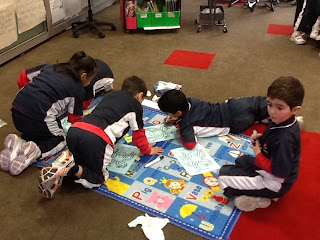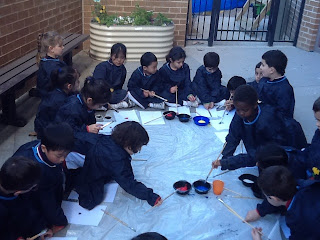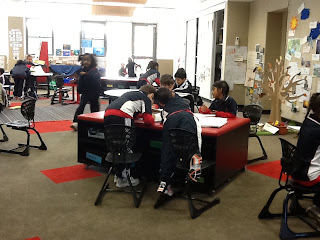Monday, 16 September 2013
Saturday, 31 August 2013
We are Maths Masters in KLS!
We have been doing lots of amazing work in Mathematics this term and so, we wanted to share some of our learning.
Multiplication & Division
We have been learning about 'groups of'. We discovered that one number can be made in lots of different ways. For example, with 12 paddle pop sticks we can make 3 groups of 4, 2 groups of 6, 1 group of 12, 12 groups of 1, 4 groups of 3 or 6 groups of 2. We also learnt that division means sharing. When we share between 2 people, even numbers have none left over and odd numbers always have left overs. Even numbers are the numbers we say when we count by 2's.
Addition & Subtraction
We played some different games to help us with adding and subtracting. Maybe you can try some at home with us! We used dominoes to help us add numbers. First we had to work out how many dots on one side of the domino without counting and then using our 'count-on' strategy, add the dots on the other side. To help us with our take away skills, we got 10 blocks each and rolled a die. The number on the die told us how many blocks to take away and then we had to figure out how many left over. We also played this game using 20 blocks.
Volume & Capacity
We had fun learning about volume and capacity. One of the activities we got to do was build a tower to see whose was the tallest, shortest or widest? Through our exploring we realised that some materials were better to use than others.
Multiplication & Division
We have been learning about 'groups of'. We discovered that one number can be made in lots of different ways. For example, with 12 paddle pop sticks we can make 3 groups of 4, 2 groups of 6, 1 group of 12, 12 groups of 1, 4 groups of 3 or 6 groups of 2. We also learnt that division means sharing. When we share between 2 people, even numbers have none left over and odd numbers always have left overs. Even numbers are the numbers we say when we count by 2's.
Addition & Subtraction
We played some different games to help us with adding and subtracting. Maybe you can try some at home with us! We used dominoes to help us add numbers. First we had to work out how many dots on one side of the domino without counting and then using our 'count-on' strategy, add the dots on the other side. To help us with our take away skills, we got 10 blocks each and rolled a die. The number on the die told us how many blocks to take away and then we had to figure out how many left over. We also played this game using 20 blocks.
Volume & Capacity
We had fun learning about volume and capacity. One of the activities we got to do was build a tower to see whose was the tallest, shortest or widest? Through our exploring we realised that some materials were better to use than others.
Sunday, 4 August 2013
What else changes?
After our chicks sadly left us at the end of week 2, we continued to look at what other things change. KLS 1 explored how colours change. In the photos below we see how students became artists and experimented with paint to discover what happens when two colours are mixed together. They found out that two primary colours, such as blue and red, make a new colour - purple. What other examples do you know?
KLS 2, on the other hand, took on the role of gardeners. In small groups they planted a bean in a clear cup, and added cotton wool and water. Unlike when we plant seeds in the garden, planting them in a clear cup has enabled us to observe the seed as it changes and grows.
KLS 2, on the other hand, took on the role of gardeners. In small groups they planted a bean in a clear cup, and added cotton wool and water. Unlike when we plant seeds in the garden, planting them in a clear cup has enabled us to observe the seed as it changes and grows.
Some of our observations and questions so far have included:
"The bean changed colour from brown to green."
"There is a white string growing out of our bean."
"Is it a sprout or a root?"
"The white string has grown longer and now another one has started to grow as well."
"Is our bean going to grow as tall as the beanstalk in 'Jack and the Beanstalk'?"
Sunday, 21 July 2013
What a cracking start to Term 3!!!
We have some visitors to our learning studio this term. Below is short clip showing a snippet of one of the eggs hatching. We numbered the eggs so that we could tell which one had hatched and even tried to predict which number egg would hatch first! We had some very different ideas about what might come out of the egg. Could it be a crocodile? a duck? a chicken? What colour would the first creature be? We were very clever in making connections with what we had experienced on our farm excursion. And then before we knew it the first egg began to hatch and all was revealed...a yellow baby chick was born! Egg number 8 had won!
The chicks are very cute but they are also very useful in helping with our learning this term. Our inquiry unit is on 'Change' and so they have helped to ignite our thinking about what changes? Maybe you can help us find some other things that change at home!
The chicks are very cute but they are also very useful in helping with our learning this term. Our inquiry unit is on 'Change' and so they have helped to ignite our thinking about what changes? Maybe you can help us find some other things that change at home!
Wednesday, 12 June 2013
A new sight word and sentence structure app
Here is another great app that we use in our Learning studio all the time. This app helps us to practise our sight words as well as helping us to become independent readers who read for meaning. First a sentence is read aloud, then the words scatter and jumble and finally we have to put the sentence back in order and read it to make sure it makes sense.
Just click on the link below.
https://itunes.apple.com/au/app/read-on-sight-free/id434349833?mt=8
Tuesday, 4 June 2013
BOOK WEEK
This week we have been reading the following book for book week:
I wonder which book we will read next and which book will win?
The Terrible Suitcase . . .
I wonder mums and dads, what's in the suitcase?
Maybe this is a conversation you can have with your child tonight!
I wonder which book we will read next and which book will win?
The Terrible Suitcase . . .
I wonder mums and dads, what's in the suitcase?
Maybe this is a conversation you can have with your child tonight!
Making Butter
We have been looking at Information books this term and have learnt many new things. We have read about pigs, cows, goats and many other interesting animals, people and topics.
Did you know that an information book has a Contents page and a Glossary? Did you know that the author uses real photos? Or, did you know that each page has a different title? No - well let us tell you all about it. All you have to do is ask me and I will tell you everything I know?
One of the facts we read, is that a goat produces more milk than any other farm animal. Even more than a cow. Did you know that milk can be used to make many different things such as yoghurt, thick cream, ice-cream, cheese and even chocolate!!!
Well today we decided to make butter and we learned that the things we need to make butter are called ingredients or materials. Here are the ingredients we needed to use today:-
- one bottle of thick cream
- one container that has a lid and
- one marble
Next we had to predict how we were going to make the butter using these ingredients and materials and guess what - our predictions were right,
These were the steps we had to follow:-
1. OPEN the lid of the thick cream.
2. POUR the cream into the container just like this.
3. PUT the marble in the container with the cream.
4. SCREW the lid on the container (or jar) and make sure the lid is on tight.
5. SHAKE the container up and down just like this.
Oohhh not ready yet, keep shaking
Wow, getting there but still not ready. Keep on shaking.
Now just spill the water and give it a few more shakes. Can you see how the colour has changed?
And there you go....you have butter. You can even see the three different stages of making our butter.
This was so much fun that we are now going to use our butter to make some fairy bread. We can't wait. to taste our butter. We wonder what it will taste like?
Well...... guess what??? The butter tasted just like any other butter!
We used our butter today to make our Fairy Bread. Here is our procedure for making fairy Bread.
Our Title: Fairy Bread
Our Goal : To make Fairy Bread.
Our Ingredients:-
- Butter
- hundreds and thousands or sprinkles
- sliced bread
- a butter knife
- a plate
The steps we followed to make our Fairy Bread:-
Step 1: Place a piece of bread on a plate.
Step 2: Cut the piece of bread in half.
Step 3: Put some butter on your butter knife and then spread the butter on your piece of bread just like this.
Step 4: Sprinkle some hundreds and thousands over your buttered bread just the way I am.
Step 5: Eat your fairy bread and enjoy! I know we are!!
Did you know that the words take, place, cut, spread, sprinkle and eat are all verbs. That means they are action/doing words. Can you think of other verbs that we can use when following a procedure???
Friday, 31 May 2013
Sight Word Apps
Here are some apps that we use in the learning studio to help us learn our Sight words. We love using them as they are really helping us learn and remember our words. We would love to use them at home too. They are challenging and fun. So mum and dad, have a look and see what you think.....
1.Word Bingo - $0.99
1.Word Bingo - $0.99
Here is the link:-
2. Play Sight Words - and this one is free
Here is the link:-
3. Play Sight Words - and this one is free too
Here is the link:-
https://itunes.apple.com/in/app/sight-words-list-learn-to/id447065810?mt=8
Here is the link:-
https://itunes.apple.com/in/app/sight-words-list-learn-to/id447065810?mt=8
Partners of Ten
This week we have been learning about addition. We have used different types of concrete materials such as counters, paddle pop sticks, tens frames and numicon shapes to explore all the different ways that we can make ten.
Here are some of our combinations using our Numicon Frames:-

7 and 3 makes 10 or
3 and 7 makes 10
Here are some of our combinations using our Numicon Frames:-
5 and 5 makes 10
6 and 4 makes 10 or
4 and 6 makes 10
9 and 1 makes 10 or
1 and 9 makes 10

7 and 3 makes 10 or
3 and 7 makes 10
2 and 8 makes 10 or
8 and 2 makes 10
This week KLS1 learned a new EMU warm-up game called 'Roll and Collect'. This games helped us with our addition skills and finding ways to count on or simply count using a quicker way.
How to play:
We play roll and collect in pairs.
Each pair has a bundle of paddle pop sticks, counters or other concrete materials as well as one dice. During this game Miss Tomasic is the time keeper and gives us one minute to complete this taks.
The task is that within one minute, each pair continously takes turn to roll a dice and then collect that many objects. Once time is up, each partner counts how many objects they have altogether. Some students count by 1's, some are beginning to count by 2's.
Maybe we could play together at home???
Today (4/6/13) Our task was to explore how we could use two die to add numbers together.
Well we discovered that if we rolled the dice we could use the two numbers to create an addition number sentence. For example if we rolled the above numbers we could record that 6 and 5 makes 11 AND we could count on too. Instead of counting every dot one by one, we could start with the number 6 and count on the other 5 by saying, 7, 8, 9, 10,11. How amazing are we???
Take a look at us hard at work...
How amazing are we?????
Subscribe to:
Comments (Atom)
































































